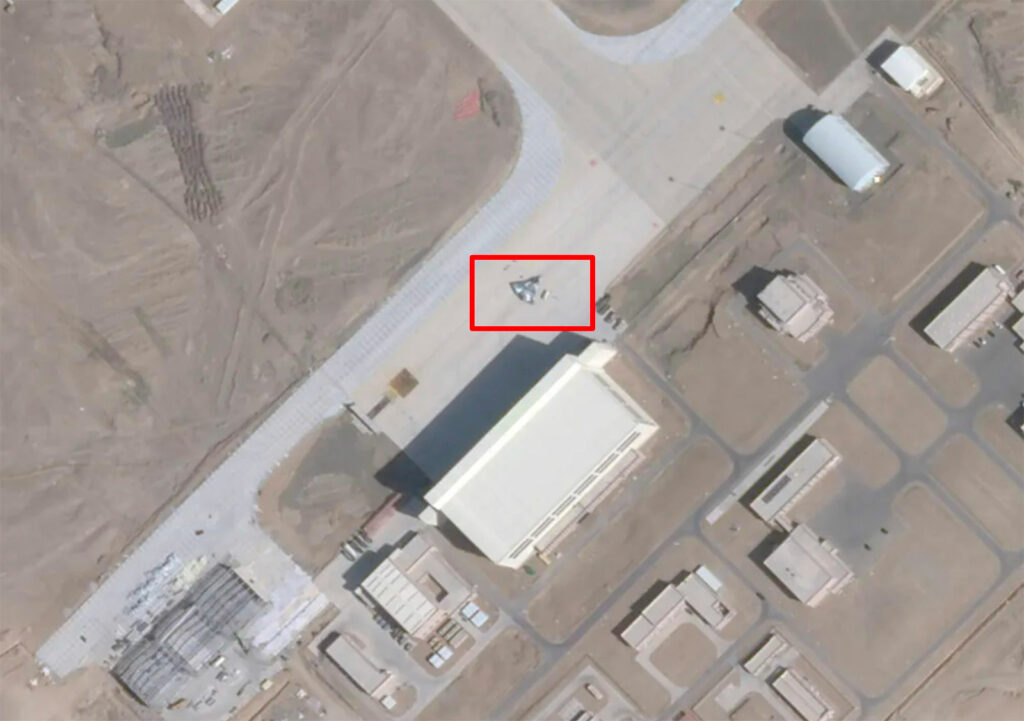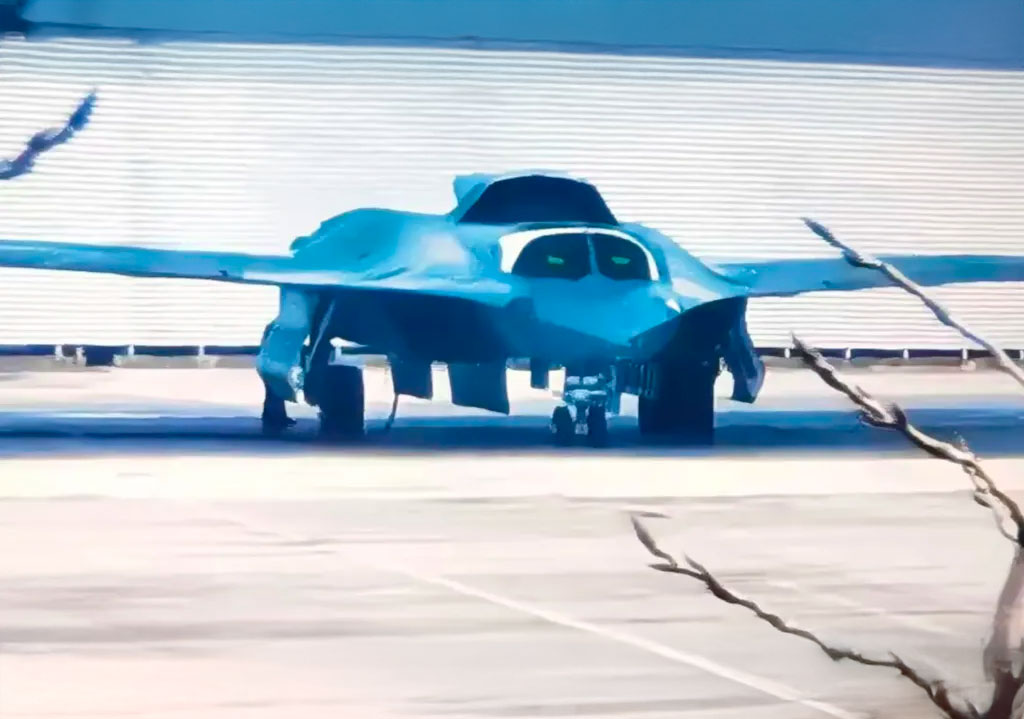
Satellite images reveal the J-36 and J-XDS operating from Lop Nur, signaling a ramp-up in China’s sixth-generation fighter programs.
Summary
Commercial satellite imagery has identified two tailless Chinese stealth fighters — the J-36 (tri-engine, large modified delta) and J-XDS (twin-engine with “lambda” wing) — operating from the remote Lop Nur base. The runway there measures approximately 5,000 m. The site, already associated with reusable spaceplanes, is undergoing rapid expansion (hangars, apron, buildings). Estimated dimensions place the J-36 (about 19.8 m wingspan, 18.9 m length) in the “heavy” category, surpassing Flankers (approx. 14.7 m wingspan). The J-XDS is more compact (≈15.2 m wingspan). In parallel, China is accelerating tests of advanced drones at Malan, including a large “cranked-kite” and a navalized variant of the GJ-11 (“GJ-21“). Overall, this suggests a methodical industrialization of stealth, propulsion, and Collaborative Combat Aircraft building blocks.
The Lop Nur Site and Test Industrialization
The base near Lop Nur combines three key attributes: geographic isolation, a very long runway (≈16,400 ft, or ≈5,000 m), and modular infrastructure. Recent imagery shows expansion of the central apron, new hangars at both ends, and a cluster of technical buildings to the southeast. This layout follows a “test aero-campus” logic: separation of flows (experimental aircraft, drones, fuel logistics), sensor/propulsion preparation cells, and heightened secrecy zones. The decision to briefly expose airframes outdoors in daylight — despite regular commercial imaging — implies a calculated trade-off: capitalizing on weather windows and test slots without halting campaigns for visual signature constraints. The site’s history with reusable spaceplanes, noted as early as 2020, has acted as a catalyst: a very long runway minimizes risks during landings of heavy, high-lift-to-drag vehicles and prepares approach profiles for prototypes with high wing loading. In the short term (12-24 months), completion of multiple hangars foreshadows cohabitation of several test lines: manned sixth-generation airframes, CCA drones, and sensor/data-link test platforms. This positions Lop Nur as a Chinese equivalent to “Area 51,” with greater emphasis on air-space hybrids and autonomy.

The J-36 Fighter: Architecture, Dimensions, and Propulsion Hypotheses
Satellite-derived measurements give the J-36 a wingspan of about 19.8 m and length of nearly 18.9 m. The heavily modified delta wing, lacking vertical stabilizers, reduces radar echoes in azimuth and elevation while providing substantial internal volume for fuel and bays. The tri-engine configuration is unusual and may address three technical constraints: 1) maintaining high total thrust with smaller-diameter engines better integrated (“flushed”) into the airframe; 2) distributing exhaust plumes thermally to lower infrared signature; 3) providing propulsion redundancy during early tests. Air intakes aligned with the leading-edge sweep suggest S-ducts and RAM treatments in the ducts. At a takeoff weight comparable to an F-111 (≈21-24 t empty historically) but with composites and modern flight controls, internal payload could reach 2-4 t over a 1,500-1,800 km radius without refueling, adjustable for engine efficiency and fuel fraction. The tailless geometry requires yaw control via thrust differential and marginal control surfaces, demanding robust fly-by-wire laws and mature inertial/data-fusion sensor suites. This aligns with a long-range penetration demonstrator capable of carrying passive/active ISR sensors and stand-off munitions, or acting as a “quarterback” for CCA packages.
The J-XDS Demonstrator: Role, Size, and Complementarity
The J-XDS appears more compact (≈15.2 m wingspan) and sleeker, with a “lambda” wing: sharp sweep at the root tapering toward the tips, optimized to delay shock waves in transonic flight while maintaining continuous trailing edges for control. Twin engines reduce complexity compared to the tri-engine setup, lowering weight and simplifying maintenance during testing. Its size places it in the heavy fighter class but below the J-36, suggesting two philosophies: one focused on range and internal capacity (J-36), the other on high-altitude maneuverability and signature management over shorter profiles (J-XDS). Recent sequences near Chengdu showing paired flights with J-20 support “mixed-generation teaming” experiments: a fifth-generation aircraft as scout/relay and a sixth-generation testing discreet links, shared targeting, and dynamic weapon allocation. Operationally, this translates to sensor-to-shooter timelines <1 s over 150-200 km, intra-package network latency <50 ms, and adaptive LPI/LPD (Low Probability of Intercept/Detection) management. The J-XDS may also serve as a testbed for conformal antennas and expanded ESM sensors, essential for multi-band situational awareness without compromising RCS.
The Test Network: Malan, Large Drones, and CCA Scaling
China’s investments extend beyond Lop Nur. The Malan base (Xinjiang) has long featured alignments of operational and experimental drones, with recent appearances of a very large “cranked-kite” type GJ-X, sized like a scaled-down stealth bomber. These platforms, with wingspans estimated >20 m, indicate ambitions for HALE (High-Altitude Long Endurance) persistence with heavy ISR payloads and air-to-air comms relays. The Malan-Lop Nur linkage creates a vertical test chain: Malan for maturing strategic drones (long flights, endurance profiles, wide-aperture sensor tests); Lop Nur for complex manned prototype flights and combined scenarios. For Collaborative Combat Aircraft, this means testing 3-8 t effectors at sub-supersonic speeds, with 300-800 kg payloads for SEAD/DEAD, ISR escort, and directional jamming. Recent images show at least one giant flying wing in flight campaigns, confirming progression from taxiing. The quantified goal: lifecycle costs per effector <20-30% of a manned fighter, with 1:3 to 1:6 (manned:CCAs) ratios by mission. This dilutes risk through saturation and preserves high-value manned airframes.
Naval Aspects: From GJ-11 to GJ-21 and Carrier Extension
On the maritime side, recent imagery shows a navalized GJ-11 variant (unofficially “GJ-21“) in flight with deployed arrestor hook. This evolution targets integration on large continuous-deck ships (Type 076/”Sichuan”), for simulated then real catapult/arrestor cycles. Technically, it requires structural reinforcements (landing gear, spars), tolerance for 4-6 m/s vertical impacts, and corrosion/salt resistance. Operational benefits are significant: projecting stealth flying wings 1,000-1,500 km from the naval group for ISR relays and low-RCS cruise missile strikes. By multiplying sensors and distributed EW nodes, a carrier air wing creates a continuous EM “veil” around the group while keeping manned fighters outside A2/AD bubbles. For Beijing, the missing link is standardized low-intercept air-sea links, interoperable across manned fighters, UCAVs, and fixed-wing carrier aircraft. Visible tests suggest a roadmap: short-term naval UCAV campaigns, then coordinated integration with a sixth-generation fighter in combined air-sea exercises.

Capability Implications: Sensors, Links, and Mass Savings
Shifting to tailless airframes involves trade-offs: reduced stability, denser digital flight controls, and careful flow management around intakes. The payoff is generous internal volume and omnidirectional RCS reduction. Sensor lines follow: conformal AESA panels, multi-band cooled IRST, and fine-goniometry ESM suites. Quantitatively, open architectures can cut sensor-platform integration times by 20-30% between blocks. For links, China must balance high data rates (SAR/IRST video) with discretion (LPI/LPD); narrow beams, agile frequencies, and pseudo-random waveforms are likely. Mass savings stem from maturing TRL in materials and processes: high-compaction carbon/epoxy panels, durable RAM joints (>1,000 h between touch-ups), and erosion-resistant leading edges for sand/salt. Overall, the Lop Nur/Malan ecosystem outlines a systemic approach: stealth airframe, staged propulsion, distributed sensors, and resilient intra-package C2. Mixed patrols with Chengdu J-20 reinforce this, previewing packages where humans orchestrate and autonomous effectors saturate.
Industrial and Strategic Consequences for Air Balance
Industrially, Chengdu and Shenyang coexisting on divergent paths (long-range tri-engine vs. compact twin-engine) avoids single-concept dead ends. This maximizes cross-learning and fosters internal competition for rapid maturity. The signal to rivals is twofold: China can fly multiple demonstrators concurrently and maintains a multi-site test network for intensive campaigns. Strategically, this acceleration pressures Western timelines (NGAD, GCAP). Even without immediate production, credible demonstrators alter staff assumptions: inflated air defense costs, ISR bubble recalibration, and stand-off munition stock revisions. In the Indo-Pacific, the “long-range stealth fighter + CCA + naval UCAV” combo creates a hard-to-disrupt air-sea continuum without clear information superiority. Budgetarily, collaborative effectors aim for reduced strike costs: if a CCA costs €10-20M to build and survival is number-optimized, adversaries must commit high-cost interceptors and long-range missiles, yielding unfavorable economics. Frankly, China’s rapid industrialization of “sixth-generation” building blocks is now a structuring factor in Asia’s air balance, regardless of fielding speed.
War Wings Daily is an independant magazine.